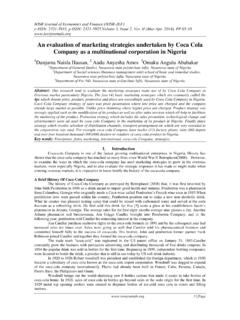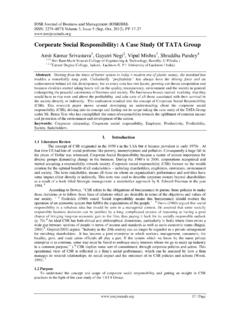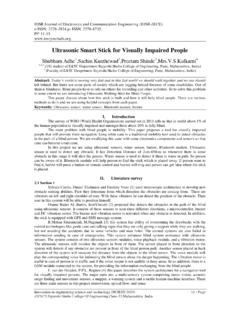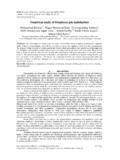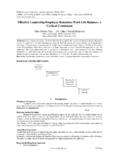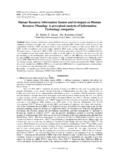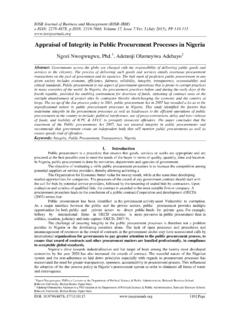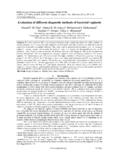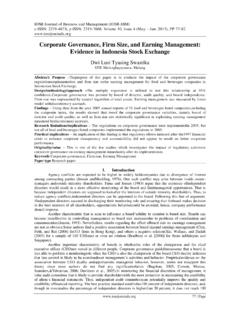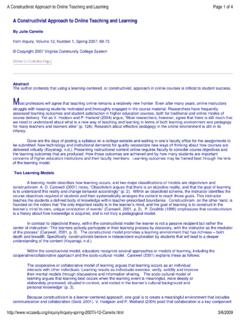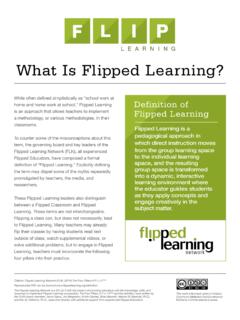Transcription of Constructivism Learning Theory: A Paradigm for Teaching ...
1 IOSR Journal of Research & Method in Education (IOSR-JRME). e-ISSN: 2320 7388,p-ISSN: 2320 737X Volume 5, Issue 6 Ver. I (Nov. - Dec. 2015), PP 66-70. Constructivism Learning Theory: A Paradigm for Teaching and Learning Dr. BADA, Steve Olusegun Depart ment of Psychology Federal Un iversity of Education, Kano Abstract: Constructivism represents one of the big ideas in education. Its implications for how teachers teach and learn to teach are enormous. If our efforts in reforming education for all students are to succeed, then we must focus on students. To date, a focus on student-centered Learning may well be the most important contribution of Constructivism . This article, therefore, discusses Constructivism Learning theory as a Paradigm for Teaching and Learning . Constructivism is a Learning theory found in psychology which explains how people might acquire knowledge and learn. It therefore has direct application to education. The theory suggests that humans construct knowledge and meaning from their experiences.
2 Conceptual understanding of the theory was discussed as well as basic characteristics of constructivists Learning environment. Seven pedagogical goals of constructivist Learning environments and six benefits of Constructivism were outlined in this article. Significant differences between traditional classroom and constructivist classroom were spelt out in a tabular form. Furthermore,principles of Constructivism and several implications of Constructivism for Teaching and learningwere reviewed. The study, therefore, concluded that teachers need to reflect on their practice in order to apply these ideas to their work and that constructivist teachers encourage students to constantly assess how the activity is helping them gain understanding. Keywords: Constructivism , Learning theory, Paradigm , Teaching and Learning I. Introduction An important restriction of education is that teachers cannot simp ly transmit knowledge to students, but students need to actively construct knowledge in their own minds.
3 That is, they discover and transform informat ion, check new informat ion against old, and revise rules when they do not longer apply. This constructivist view of Learning considers the learner as an active agent in the process of knowledge acquisition. Constructivist conceptions of Learning have their historical roots in the work of Dewey (192 9), Bruner (1961), Vygotsky (1962), and Piaget (1980). Bednar, Cunningham, Duffy, and Perry (1992) and von Glasersfeld (1995). have proposed several imp licat ions of constructivist theory for instructional developers stressing that Learning outcomes should focus on the knowledge construction process and that Learning goals should be determined fro m authentic tasks with specific objectives. Similarly, von Glasersfeld (1995) states that Learning is not a stimulus-response phenomenon, but a process that requires self-regulation and the development of conceptual structures through reflection and abstraction. It is important to note, in this respect, that Constructivism is embodied in numerous ways and that these different views share important overlaps, but also c ontain major differences.
4 Constructivism is an approach to Teaching and Learning based on the premise that cognition ( Learning ). is the result of "mental construction." In other words, students learn by fitting new information together with what they already know. Constructivists believe that Learning is affected by the context in wh ich an idea is taught as well as by students' beliefs and is a Learning theory found in psychology which exp lains how people might acquire knowledge and learn. It therefore has direct application to education. The theory suggests that humans construct knowledge and meaning from their experiences. Constructivism is not a specific pedagogy. Piaget's theory of Constructivist Learning has had wide ranging impa ct on Learning theories and Teaching methods in education and is an underlying theme of many education reform movements. Research support for constructivist Teaching techniques has been mixed, with some research supporting these techniques and other research contradicting those results.
5 Driscoll (2000) exp lains that constructivist theory asserts that knowledge can only exist within the human mind, and that it does not have to match any real world reality. Learners will be constantly trying to derive their own personal mental model of the real wo rld fro m their perceptions of that world. As they perceive each new experience, learners will continually update their own mental models to reflect the new informat ion, and will, therefore, construct their own interpretation of reality. According to Jonassen (1994), Constructivism is also often misconstrued as a Learning theory that compels students to "reinvent the wheel." In fact, Constructivism taps into and triggers the student's innate curiosity about the world a nd how things work. Students do not reinvent the wheel but, rather, attempt to understand how it turns, how it functions. They DOI: 66 | Page Constructivism Learning Theory: A Paradigm for Teaching and Learning become engaged by applying their existing knowledge and real-world experience, Learning to hypothesize, testing their theories, and ultimately drawing conclusions from their findings.
6 Constructi vism Theory of Learning Explai ned Constructivism is basically a theory which is based on observation and scientific study, about how people learn. It says that people construct their own understanding and knowledge of the wo rld, through experiencing things and reflecting on those experiences (Bereiter, 1994). When we encounter something new, we have to reconcile it with our previous ideas and experience, maybe changing what we believe, or maybe discarding the new information as irrelevant. In any case, we are active creators of our own knowledge. To do this, we must ask questions, exp lore, and assess what we the classroom, the constructivist view of Learning can point towards a number of different Teaching practices. In the most general sense, it usually means encouraging students to use active techniques (experiments, real-world problem solving) to create more knowledge and then to reflect on and talk about what they are doing and h ow their understanding is changing.
7 The teacher makes sure he/she understands the students' preexisting conceptions, and guides the activity to address them and then build on them (Oliver, 2000). Constructivism has roots in philosophy, psychology, sociolo gy, and education. But while it is important for educators to understand Constructivism , it is equally important to understand the implications this view of Learning has for Teaching and teacher professional development (Tam, 2000). Constructivism 's central idea is that human Learning is constructed, thatlearners build new knowledge upon the foundation of previous Learning . This viewof learn ing sharply contrasts with one in which learn ing is the passive transmission of information fro m one individual to another, a view in wh ich reception, not construction, is important notions orbit around the simp le idea of constructed is that learners construct new understandings using what they is no tabula rasa on which new knowledge is etched.
8 Rather, learners come to Learning situations with knowledge gained fro m prev ious experience, and that prior knowledge in fluences what new or modified knowledge they will construct from new Learning experiences (Phillips, 1995). The second notion is that Learning is active rather than passive. Learners confront their understanding in light of what they encounter in the new learn ing situation. If what learners encounter is inconsistent with their current understanding, their understanding can change to accommodate new experience. Learners remain active throughout this process: they apply current understandings, note relevant elements in new Learning experiences, judge the consistency of prior and emerging knowledge, and based on that judgment, they can modify knowledge (Phillips, 1995). According to Driscoll (2000), Constructivism Learning theory is a philosophy which enhances students'. logical and conceptual growth. The underlying concept within the Constructivism Learning theory is t he role which experiences-or connections with the adjoining at mosphere-play in student Constructivism Learning theory argues that people produce knowledge and form meaning based upon their experiences.
9 Two of the key concepts within the Constructivism Learning theory which create the construction of an individual's new knowledge are accommodation and assimilation. Assimilat ing causes an individual to incorporate new experiences into the old experiences. This causes the individual to develop ne w outlooks, rethink what were once misunderstandings, and evaluate what is important, ultimately altering their perceptions. Accommodation, on the other hand, is reframing the world and new experiences into the mental capacity already present. Individuals conceive a particular fashion in which the world operates. When things do not operate within that context, they must accommodate and reframing the expectations with the outcomes. Constructivism is often compared to objectivism, wh ich is usually quoted as b eing the counter point or direct opposite of Constructivism . Much of objectivist theory is based on the work of behavioris ts such as Skinner (1953.) Objectiv ists believe that informat ion itself is knowable outside the bounds of any human mind, and that any individual interpretation of knowledge can be said to be either correct or incorrect.
10 Ob jectivists view indiv idual pieces of informat ion as symbols or currency that can be acquired by humans, and can be transferred fro m hu man to human should the correct learn ing conditions exist. (Jonass en, 1991). While much of the early work in formal instructional design derived from objectivist theory, modern academic minds have come to accept that Learning environ ments which more closely match the needs of constructivist Learning may be more effective. The perceived benefits of constructivist Learning may be particularly valuable where the Teaching of complex skills, such as problem solving or critical thinking skills are concerned (Tam, 2000.). If we accept that constructivist theory is the best way to define Learning , then it follows that in order to promote student Learning it is necessary to create Learning environ ments that directly expose the learner to the material being studied. For only by experiencing the world directly can the learner derive mean ing fro m them.
